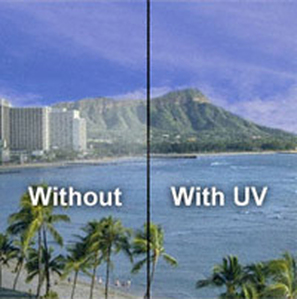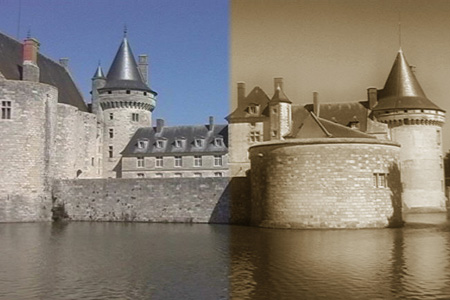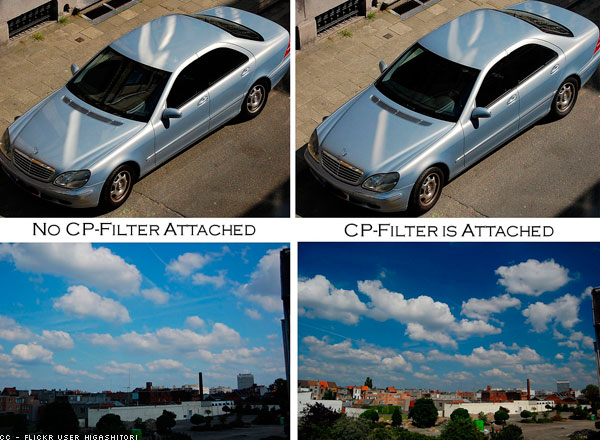Filters
What are filters?
Filters are circular (mostly glass or plastic with a metal frame) light-modifying objects that are - in most cases - mounted onto the lens of your camera.
Among great many others, the most common filters are:
UV (Ultra-Violet)
ND (Neutral-Density)
Polar (Polarizing)
Colour (Colour-modifying)
An UV filter is used to keep those nasty UV rays of the Sun out of the lens, causing less glare and lens-flare, and keeping subjects with certain surfaces from discolouring. In the digital world UV filters are mainly nothing but a protective cover for the lens. Film is sensitive to UV light, that's why this was first designed, however in the digital world it is just a leftover "artifact".
An ND filter is (to quote Mark Wallace) "a fancy pair of sunglasses for your lens". They basically just take down the light that comes into your lens a few stops. This can varies according to the strength of the filter. E.g.: an ND8 filter takes down 3 stops of light.
This enables you to take longer exposure shots, even if there is plenty of sunlight, and you can can't take your ISO down anymore, and you don't want (or can't) increase your AV.
Also when using an ND filter enabling you to use longer shutter speeds, colors tend start to show up more vibrant and live.
Polar filters are a strange kind. They are very special surface filters that can filter (dim) reflections, some over-exposed parts of a scene, even TV or LCD screens! The Polar filter changes its filtering mode or angle as you rotate the filter on your lens.
Careful! When you focus and the end of the lens (where the filter is mounted) the filter rotates as well as your focus lens. To maintain filtration, hold the filter ring during autofocus (be cautios not to disable the autofocus lens from rotating)... or better yet: use autofocus BEFORE you rotate your filter.
Color filters are just colored glasses for your lens to filter out or in some colours of the picture. E.g.: if you install a slight orange-toned filter, your image will get a nice soft sepia tone.
Filters are circular (mostly glass or plastic with a metal frame) light-modifying objects that are - in most cases - mounted onto the lens of your camera.
Among great many others, the most common filters are:
UV (Ultra-Violet)
ND (Neutral-Density)
Polar (Polarizing)
Colour (Colour-modifying)
An UV filter is used to keep those nasty UV rays of the Sun out of the lens, causing less glare and lens-flare, and keeping subjects with certain surfaces from discolouring. In the digital world UV filters are mainly nothing but a protective cover for the lens. Film is sensitive to UV light, that's why this was first designed, however in the digital world it is just a leftover "artifact".
An ND filter is (to quote Mark Wallace) "a fancy pair of sunglasses for your lens". They basically just take down the light that comes into your lens a few stops. This can varies according to the strength of the filter. E.g.: an ND8 filter takes down 3 stops of light.
This enables you to take longer exposure shots, even if there is plenty of sunlight, and you can can't take your ISO down anymore, and you don't want (or can't) increase your AV.
Also when using an ND filter enabling you to use longer shutter speeds, colors tend start to show up more vibrant and live.
Polar filters are a strange kind. They are very special surface filters that can filter (dim) reflections, some over-exposed parts of a scene, even TV or LCD screens! The Polar filter changes its filtering mode or angle as you rotate the filter on your lens.
Careful! When you focus and the end of the lens (where the filter is mounted) the filter rotates as well as your focus lens. To maintain filtration, hold the filter ring during autofocus (be cautios not to disable the autofocus lens from rotating)... or better yet: use autofocus BEFORE you rotate your filter.
Color filters are just colored glasses for your lens to filter out or in some colours of the picture. E.g.: if you install a slight orange-toned filter, your image will get a nice soft sepia tone.






